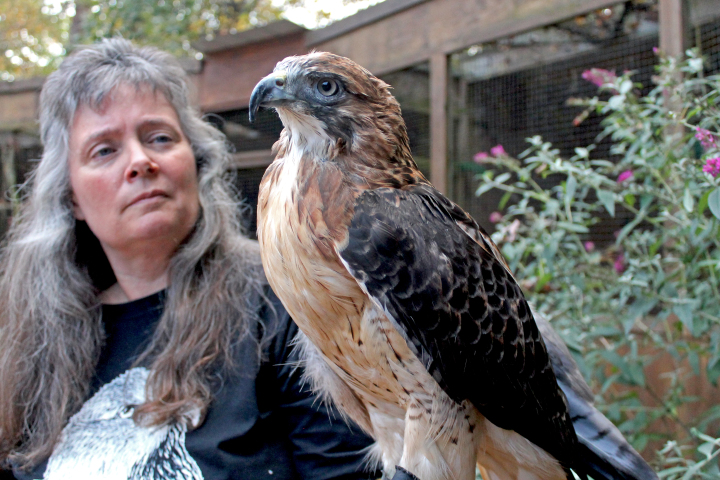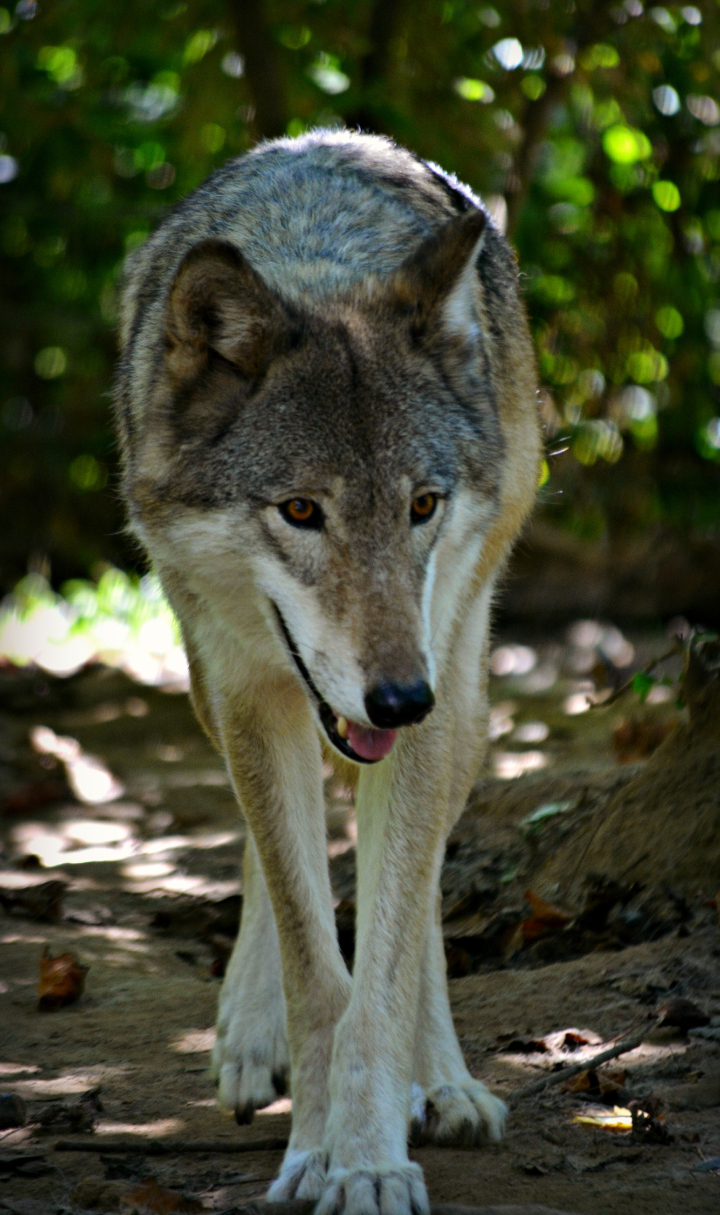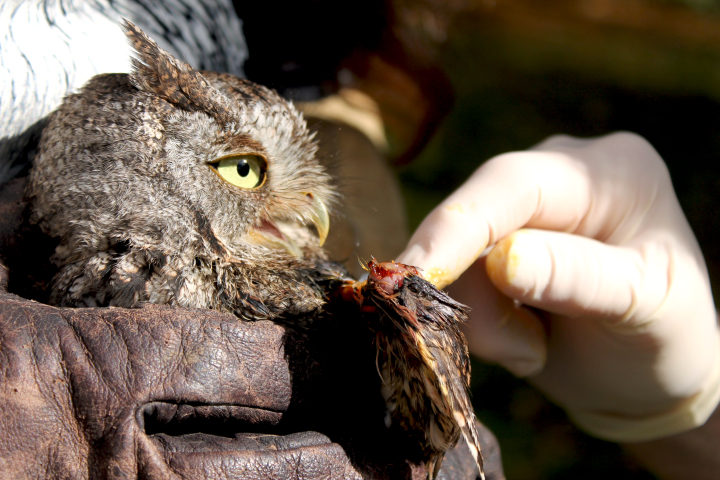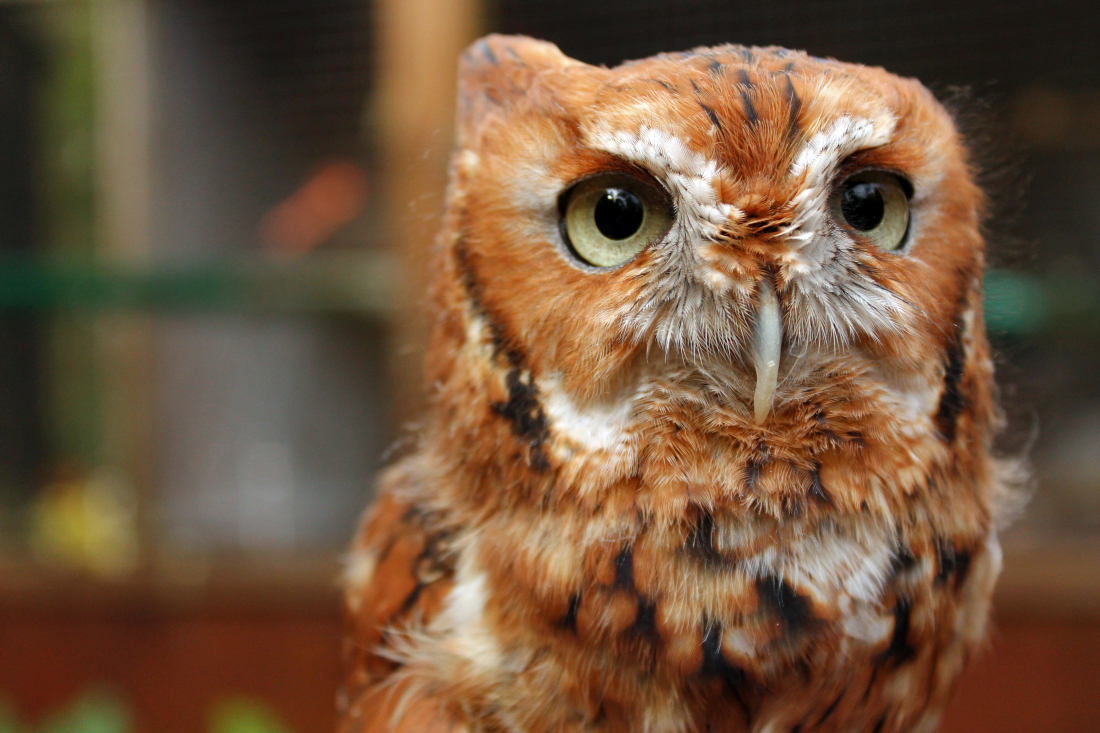“We got a call from a lady in Horse Shoe; it was a Sunday morning,” remembers Mary Beth Bryman, co-founder of Wild for Life. “There was a Canada goose in her bedroom.”
When Bryman and co-founder Susie Wright arrived at the woman’s home, she told them her husband had gone to church early that morning. After making herself a cup of coffee, she’d returned to her bedroom to open the blinds — and realized she wasn’t the only one there.
They opened the door to find a goose-massacred bedroom. “There were white curtains, white throw rugs, white bedspreads — and bird poop and blood everywhere,” Bryman reveals. “That goose had flown through a double-pane glass window, making a huge gash under its wing. Susie held [the wound] for hours to stop the bleeding; [the goose] ended up needing about 30 stitches.”

It took Wild for Life, a nonprofit rescue center for birds of prey, about seven weeks to rehabilitate the injured bird, administering antibiotics twice a day, giving it fluids and food, and cleaning the wound daily. “She recovered very nicely,” says Bryman. “We took her down to the French Broad, and she turned around and honked at us, then just started floating down the river, honking.”
If they hadn’t taken the rescue call, “I think she may have bled to death,” Bryman continues. “Without antibiotics, that wound could have gotten infected. Or, being as injured as she was, she could’ve been got by a predator. Bottom line: I think she would have died.”
Urbanization fragments habitat
“Humans are a mixed bag,” observes Katie Greenberg, project leader and research ecologist at the U.S. Forest Service’s Southern Research Station. “Generally urbanization is harmful to most animals — eliminating any kind of natural habitat, paving the ground so nothing can live in the leaf litter, removing all the forest structure.”
Urban environments, she continues, provide a home to “mainly non-native species. In suburbs, on the other hand, different things can live in places like gardens. And in the woods, you get a whole host of species. But more and more of native species’ habitats are taken up by urban sprawl, which fragments the existing habitat.”
That fragmentation has far-reaching implications. “In an ideal world, you’d have an urban area that was surrounded by a buffer of farmland — and that would be surrounded by wilderness,” says Greenberg. “But we fragment it through strip development. It’s not like we have a circle and the rest is left for the animals. The way we’re even doing suburbs now, houses are so spread apart. … It makes the actual area for wildlife smaller and smaller. Only so many animals can live in a tiny patch of forest.”
Urban wildlife and human intervention
When humans and native wildlife coexist in a developed setting, says Barbara “Kitti” Reynolds, who chairs UNC Asheville’s environmental studies department, “It becomes a topic called urban wildlife. Right now we don’t really have a problem with these two species: turkey and bears. Deer can be a major problem — they go back and forth between Biltmore Forest and Biltmore Estate. They come into the properties and eat everyone’s shrubbery. There’s no natural predator,” and if it weren’t for the hunting allowed on the estate, “The deer would just overrun all of their plantings and crops.”
“We’ve disturbed the system so much,” she continues. “We don’t have the predators we used to, and we run into overpopulation: diseases spreading easily; starving, sickly animals. And the sick ones aren’t being taken out by the predators as they normally would be.”

Even in more natural settings, notes Reynolds, the lack of predators has considerable impact. The reintroduction of gray wolves into Yellowstone National Park in the mid-1990s, she points out, has helped balance other ecosystems.
“There is this feeling that predators are bad, because they eat Bambi,” Reynolds explains. “But there’s a need for every bit and piece. The first principle of intelligent thinking is to not throw away parts of a whole — and that’s what we do when we get rid of predators.”
In Yellowstone, she says, “The elk learned to be afraid again. They go up into the higher country to watch for the wolves, which brings the reappearance of natural vegetation in the valleys that birds and other species depend on. The whole experiment seems to be working out well.”
A similar attempt to reintroduce the red wolf into Great Smoky Mountains National Park in the 1990s didn’t pan out, however. “There wasn’t enough food for them to eat. It was too small an area, with too many people on the boundaries.”
The National Park Service eventually captured the remaining wolves and transported them either to more viable habitat on the North Carolina coast or to zoos, for use in breeding programs. That left the Smokies, though, without “any large predators; bears are only predators sometimes.” And as a result, “The park doesn’t have as balanced an ecosystem as Yellowstone is striving for right now.”
Humans, says Reynolds, have “done so many things that negatively affect our ecosystems. And we can’t just let it sit: We have to go in and do something, because we’ve caused so many problems already.”
Just bear with it
Not all wild species struggle when their habitat shrinks, however: Some adapt and even thrive in an increasingly urban environment.
“In general, the bear population has been increasing for 25 years,” says Mike Carraway, a wildlife biologist at the N.C. Wildlife Resources Commission. “One of the interesting things about this dynamic is kind of counterintuitive,” he explains. “When a new housing development goes in, they close the area to hunting. That benefits the bear population: It becomes a sanctuary.”
Carraway is conducting a five-year study tracking the movements, population ecology and vulnerability of bears around Asheville. The project called for putting GPS collars on about 40 black bears, but things didn’t go entirely according to plan.
“Our goal was to catch 40 bears — 25 females and 15 males — but this summer we caught 65 different bears,” Carraway explains. He and his team had the right size GPS collars for just 44 of them, however, and nine fell off, which left 35 wearing collars. If more collars fall off, they’ll catch additional bears, with the goal of tracking 35 to 40 animals at any given time.
Since the study is still in its first year, “any findings or results will be several years down the road,” he says. “There are a lot of things we think we know about bears, and we’re hoping this study will give us some hard data to tell us if we’re right or wrong.” But in the meantime, they’re finding plenty of bears, and they’re catching them all over.
“Some stay in one little area; others take off and wander around a lot. That’s one of the focuses of the study,” he continues. “What are their motivations for whether they stay in one place or roam around? Bears live right in the middle of town. There’s not a whole lot of problems with that, but one of the reasons we decided to do this study is to try to evaluate human-bear interactions. That’s a huge issue: People react differently to bears in their yard.”
Humans, notes Greenberg, are “taking over the areas that bears used to be in, but the bears are showing themselves to be pretty adaptable. Instead of digging up a bees’ nest or finding berries, they’re digging through the trash.”
And that, in fact, is one of the main reasons they’re so easy to spot in Western North Carolina. When people see a bear rummaging through their trash can, says Carraway, “Some call 911. Others will get hot dogs and see if the bear will eat them. Both of those are problematic. … Just leave it alone. Most of the time, the bear is just passing through. If the bear is hanging around, it’s because of some sort of food source.”
His advice is simple: At night, “remove any food sources, like bird feeders or trash cans. Don’t leave pet food outside; don’t leave a greasy grill. All of those things attract bears. People don’t need to be afraid, and they don’t need to call animal control.”
Humans to the rescue
Of course, people do need to be aware of the inadvertent dangers posed by human activity.
“People throw out pieces of food thinking that it’s just going to decompose or feed something — which is accurate,” says Savannah Trantham of the WNC Nature Center. But that apple core might attract a mouse or other small rodent, and then, “An owl or hawk flies across the road to eat it and gets struck by a car.”
Trantham, the Nature Center’s assistant animal curator, says the center has seen more than 1,000 animals pass through their rehabilitation network this year, and most of those cases involved some sort of human interaction.

“We see anything and everything,” she reports. “Anything that’s native to the area, we’ve probably seen it at some point. Squirrels, both gray and flying; chipmunks, groundhogs. We get lots of rabbits, possums, mice, moles, shrews; every couple of years we get a beaver or otter.”
That’s where local animal rehabilitators come into the picture. But even trying to provide help can get complicated, depending on the species involved. “We do get five or six fawns or deer a year, but there’s a lot of regulation on what wildlife you can work with. As far as deer go, they have to be a certain size, still have their spots, and you need special permits. Not just any permitted wildlife rehabilitator can work with these animals.”
The same holds true for bears. “Black bears come through occasionally, but again, they’re heavily protected through the state. You need special permits. But we work really quickly to get them placed with the right people. And raccoons, bats, skunks, foxes and coyotes? There’s nobody in the state that can work with them at all,” Trantham says. “We directly refer them to either the N.C. Wildlife Resources Commission or the local animal control or health department.”
It’s not just a matter of senseless bureaucracy, either. Those five animals “carry the rabies virus more frequently than other animals and could pass it to the general public if they come into contact. For that reason, nobody is allowed to work with them.”
Hard choices
With so many animals coming through the system, there aren’t always enough places to send them. The Nature Center itself serves as more of a networking hub. People call in with a sick or injured animal, and the center tries to match it with a local rehabilitator. “We do the best we can with what we have,” says Trantham. “Our center isn’t a rehabilitation facility. We utilize home-based local rehabilitators. When we’re passing off all of these animals to rehabilitators, they get overwhelmed and fill up quickly.”
Rehabilitators are licensed by the state. “You don’t get paid: You do it out of the goodness of your heart,” she continues. “And it’s very different than just taking care of your dog or cat at home. We offer a course every fall and spring that teaches the public how to be a wildlife rehabilitator; maybe 50 to 60 people a year choose to go on and get their license.”
But the extent of that commitment can vary considerably. “How much time and money you put into it really is very variable, depending on what you want to take in,” Trantham explains. “A lot of animals are easier or less of a financial commitment, and some are very large. One fawn can be over $400 a month to raise, depending on what’s going on with it; a cottontail can take only $50 and a few weeks, if it’s healthy.”
Bryman and Wright of Wild for Life have been rehabilitating animals for roughly 20 and 24 years, respectively. And though most of their charges do seem to pull through, some are either too severely injured or are brought in far too late.
“It does happen, but not a lot,” Bryman explains. “If we get an animal with a wound that’s gotten infected, or they have multiple wounds, we will certainly give that animal a chance. But if, after a couple of days, you can see that it doesn’t look good, the best thing to do for that animal is to euthanize them.”
Tree of life
Clearly, not everyone is prepared to make the financial and time commitments that rehabilitating injured animals entails. But there are plenty of other ways people can help keep the region more wildlife-friendly.
Developers, for example, can refrain from clear-cutting the land when creating a new subdivision or commercial facility. “Leave as many trees as possible,” urges Bryman. “Try not to destroy the wildlife habitat.”
Reynolds and Greenberg agree.
“Leave enough trees to produce acorns for wildlife to feed on,” says Reynolds. “Birds that are cavity nesters need big, hollow trees. One of my neighbors had a big, dead oak tree that she had cut down. And I don’t blame her: It was a dead tree near her house. But the year before, there had been three baby screech owls nesting in that tree.”
The same holds true for the UNC Asheville campus, she points out. “We manicure the area, and we might plant nice little dogwoods. But there’s a need for large trees with cavities.” If that’s not possible, she says, people can put up nest boxes, “and they will make use of those.”
Greenberg adds: “There’s nothing wrong with disturbance and harvesting in these kinds of forests, if you leave about 30 percent of the trees. Urbanization can be considered bad, but other kinds of human disturbances aren’t necessarily so bad. Farms and ranches are really good for certain species — birds that like open land and shrubs. Lots of birds, like quail or meadowlarks, use grasslands or grassy areas to hide their nests.
“There’s no such thing as ‘good for every species,’” she continues. “If you just let the forest grow undisturbed, there would be a lot of species that couldn’t live there. But if you had all disturbance, lots of other native species would die off. … It’s all a balancing act.”
Photos by Hayley Benton




Before you comment
The comments section is here to provide a platform for civil dialogue on the issues we face together as a local community. Xpress is committed to offering this platform for all voices, but when the tone of the discussion gets nasty or strays off topic, we believe many people choose not to participate. Xpress editors are determined to moderate comments to ensure a constructive interchange is maintained. All comments judged not to be in keeping with the spirit of civil discourse will be removed and repeat violators will be banned. See here for our terms of service. Thank you for being part of this effort to promote respectful discussion.